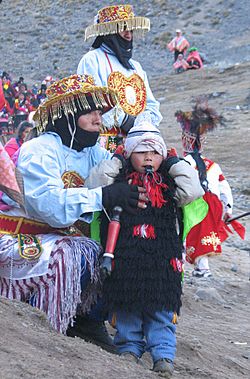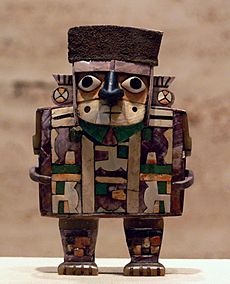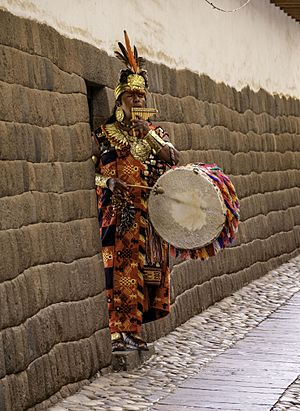Indigenous peoples of Peru facts for kids

Dancers at Quyllurit'i, an Indigenous festival in Peru
|
|
| Total population | |
|---|---|
| 5,500,000 25% of Peru's population |
|
| Regions with significant populations | |
| Mainly southern regions and Amazon basin (Apurímac, Ayacucho, Huancavelica, Cusco, Arequipa, Puno, Loreto, Junín, Pasco, Huánuco, Ucayali, and Madre de Dios). | |
| Languages | |
| Quechua, Aymara, Peruvian Spanish, and other Indigenous languages | |
| Religion | |
| Roman Catholicism, Native religions | |
| Related ethnic groups | |
| Mestizo, other Quechua, Aymara |

The Indigenous peoples of Peru are the first people who lived in the land we now call Peru. They are made up of many different ethnic groups. These amazing cultures grew and changed for thousands of years. This was long before the Spanish arrived in 1532.
In 2017, about 5.5 million Peruvians said they were Indigenous. This means they make up about 24% of Peru's total population. When the Spanish arrived, many Indigenous groups lived in the Amazon basin. These groups were often semi-nomadic. They hunted, fished, gathered food, and farmed using a method called slash and burn.
Other groups lived in the Andes mountains and to the west. They were part of the powerful Inca Empire. The Inca had a very organized society with many cities. They built huge temples and monuments using amazing stone-building skills.
Sadly, many of the estimated 2000 nations and tribes from 1500 disappeared. This happened because of the growth of the Inca Empire. It also happened after 1533, when the Spanish empire took over. Today, people of mixed Indigenous and European heritage, called mestizos, are the largest group in Peru.
When the Spanish came, many Native Peruvians died. They caught new diseases from Europe that they had no natural protection against. All Indigenous groups in Peru, even those living deep in the Amazon rainforest, have changed a bit. They have been influenced by European-Peruvian culture. They use modern tools and trade goods. Still, many work hard to keep their traditional ways and identities alive.
Contents
- Where Did Indigenous Peruvians Come From?
- How Many Indigenous People Live in Peru Today?
- How Did Spanish Arrival Change Indigenous Life?
- Education and Language for Indigenous Youth
- Indigenous Territories in Peru
- Laws and Organizations Protecting Indigenous Rights
- Indigenous Ethnic Groups of Peru
- See also
Where Did Indigenous Peruvians Come From?

Scientists believe most of the first people in the Americas came from North Asia. They crossed the Bering Strait into North America in at least three big movements. DNA studies show that most people in Peru around 1500 came from the first group of Asian travelers. These travelers might have crossed a land bridge called Beringia around 24,000 BCE. They likely reached Peru by 10,000 BCE, entering the Amazon basin from the northwest.
Peru is home to the Norte Chico civilization, the oldest known civilization in the Americas. It is one of six places in the ancient world where civilization began on its own. This includes farming and organized governments. These sites are about 100 miles north of Lima. People there traded between coastal fishermen and cotton farmers. They built huge pyramids around 3000 BCE.
Before the Spanish arrived, many different languages were spoken in Peru. These included Quechua, Aymara, and others. The people had different ways of life, social structures, and cultures.
How Many Indigenous People Live in Peru Today?
According to Peru's National Institute of Statistics, about 25.7% of the country's population is Indigenous. This is out of a total of over 31 million people. Most of them (95.8%) live in the Andes mountains. About 3.3% live in the Amazon region. Other sources say Indigenous people make up 31% of the total population.
| Population by region, 2017 | |||||
|---|---|---|---|---|---|
| Region | Percent | ||||
| Apurímac | 84.1% | ||||
| Ayacucho | 81.2% | ||||
| Huancavelica | 80.8% | ||||
| Cusco | 74.7% | ||||
| Puno | 57.0% | ||||
| Huánuco | 42.9% | ||||
| Pasco | 37.7% | ||||
| Junín | 34.9% | ||||
| Madre de Dios | 34.5% | ||||
| Ancash | 34.0% | ||||
| Arequipa | 31.1% | ||||
| Lima | 17.5% | ||||
| Lima Province | 16.3% | ||||
| Moquegua | 14.6% | ||||
| Ica | 14.3% | ||||
| Callao | 10.2% | ||||
| Tacna | 7.3% | ||||
| Cajamarca | 6.2% | ||||
| San Martín | 5.1% | ||||
| Ucayali | 5.0% | ||||
| Lambayeque | 4.2% | ||||
| La Libertad | 2.9% | ||||
| Amazonas | 2.9% | ||||
| Piura | 2.2% | ||||
| Tumbes | 1.9% | ||||
| Loreto | 1.4% | ||||
In the Amazon region, there are more than 65 different ethnic groups. They speak languages from 16 different language families. Peru is thought to have the most uncontacted tribes in the world. This is after Brazil in South America and New Guinea in the Pacific Ocean.
How Did Spanish Arrival Change Indigenous Life?
After Spanish soldiers arrived in Peru, many local people started to die. They caught diseases from Europe that were new to them. These diseases spread quickly along trade routes. Indigenous peoples had no natural protection against them. This caused many deaths.
Marriage and Family Life
Before the Spanish arrived, Inca people often had "trial marriages." These would last a few years. At the end, the man and woman could decide to stay together or go their separate ways. Women usually married around 16 years old, and men around 20.
In Andean cultures, men's and women's work was seen as equally important. They depended on each other to survive. Once married, women often cared for children and animals. They also collected food, cooked, and wove. Men usually took on more physically demanding tasks.
Intermarriage with Other Cultures
Early on, Spanish soldiers and settlers married Indigenous women. Some Spanish leaders married into Inca noble families. Over time, many Peruvians became mestizo. This means they have both Indigenous and European ancestors. They usually speak Spanish and are Roman Catholic.
In the late 1800s, many Chinese men came to Peru to work. They often married non-Chinese women, including Indigenous Peruvians. These marriages created new mixed cultures. Chinese men also married Peruvian women in cities. These women often came from Andean and coastal areas to find work.
Education and Language for Indigenous Youth
There are often big differences in test scores between Indigenous and non-Indigenous students. Peru has over 60 different Indigenous language groups. Not all of these languages are officially recognized. Language barriers to education are a bigger problem in the Andes mountains and the Amazon jungle. They are less common in coastal cities.
Since the mid-1900s, Peru has tried to improve education for Indigenous communities. They started bilingual education. This means teaching in both Spanish and Indigenous languages like Quechua. Quechua became an official language of Peru in 1975. It is still recognized as equal to Spanish in some areas.
Many people believe bilingual education helps create a more fair and respectful society. It helps Indigenous groups keep their culture and gain rights. However, some Quechua speakers have disagreed. They felt that learning Spanish was the only way to get ahead in life.
Even with good laws, putting bilingual education into practice has been hard. Teachers sometimes lack the resources or training. But studies have shown that using a child's native language in school helps them learn better. It encourages them to speak and write more.
Many groups are working to improve Indigenous education. The National Division of Intercultural Bilingual Education (DINEBI) is one example. The Program for the Training of Native Bilingual Teachers (FORMABIAP) helps teachers in the Amazon region.
Indigenous Territories in Peru
Indigenous people own large parts of Peru. These are often called communal reserves. The largest Indigenous communal reserve belongs to the Matsés people. It is located on the border with Brazil, near the Javary River.
Laws and Organizations Protecting Indigenous Rights
In 1994, Peru signed an important international law. It is called the Indigenous and Tribal Peoples Convention, 1989. This law says governments must make sure Indigenous peoples have equal rights. It also says they must protect their cultures. Governments should help close the gaps between Indigenous peoples and the rest of the country.
To do this, governments must talk to Indigenous communities. They need to ask for their opinions on laws that affect them. They should also help Indigenous peoples take part in making decisions. Peru's commitment to this law is sometimes debated. Especially when it comes to using Indigenous lands for money-making projects. Indigenous peoples only gained the legal right to be consulted in 2011.
Political Organizations and Self-Governance
One important informal organization is the Rondas Campesinas. These are local groups that protect their communities. They started in the late 1960s to guard against land invasions. They became more official when they helped fight against the Shining Path guerrilla movement. Rondas Campesinas still exist in northern Peru.
Recently, there has been a push for Indigenous communities to have their own regional governments. The Wampis Nation in the Peruvian Amazon was the first to create its own government in 2015. Other groups like the Kandozi and Shawi have followed. These governments aim to protect their lands from outside companies. They also want to improve talks between the Peruvian government and Indigenous communities.
Other groups work to represent Indigenous interests in Peruvian politics. AIDESEP (Interethnic Association for the Development of the Peruvian Jungle) defends the rights of 64 Indigenous groups in the Amazon. MATSES (Movement in the Amazon for Tribal Subsistence and Economic Sustainability) is another group. It is run by members of the Matsés community. Their goal is to protect Matsés culture and lands without outside influence.
Indigenous Ethnic Groups of Peru
- Achuar, Amazon
- Aguano, Amazon
- Aguaruna, Amazon, northern Peru
- Amahuaca, Amazon, eastern Peru
- Asháninka, Amazon: Junín, Pasco, Huánuco, and Ucayali Regiona
- Aymara, who live primarily in the south.
- Bora, Amazon, north and eastern Peru
- Candoshi, Amazon: Loreto Region
- Cashibo, Amazon
- Chanka, whose direct descendants live primarily in Apurímac, Ayacucho and Lamas.
- Chincha, formerly the Pacific Coast
- Cholones, Amazon
- Cocama
- Cocamilla
- Ese Ejja, Amazon: Madre de Dios Region
- Harakmbut, Amazon: Madre de Dios Region
- Huambisa, Amazon
- Jibito, Amazon
- Jivaro, Amazon, northern Peru
-
- Shuar, Amazon
- Kaxinawá, Amazon
- Kulina, Amazon
- Korubo
- Machiguenga, Amazon, southeastern Peru
- Machinere, Amazon
- Maina, Amazon
- Mashco-Piro, Amazon: Madre de Dios Region
- Matsés (Mayoruna), Amazon
- Muinane
- Norte Chico civilization (9210–1800 BCE), Pacific coast
- Pocra culture (500–1000 CE), Pacific coast
- Ocaína
- Q'ero, Andes: Cusco Region
- Quechua, direct descendants of the common people from the Inca Empire, who are the majority in the coastal and Andean regions.
-
- Quijos-Quichua, lowland Quechua of the Napo river. Amazon: Loreto Region
- Canelos-Quichua, lowland Quechua of the Tigre and Corrientes rivers. Amazon: Loreto Region
- Southern Pastaza Quechua, lowland Quechua primarily living south of Andoas in the Pastaza River basin. Amazon: Loreto Region
- Kichwa-Lamista, lowland Quechua living along the Huallaga and Mayo rivers. Amazon: San Martín Region
- Secoya, Amazon, northern Peru
- Shapra, Amazon: Loreto Region
- Shipibo-Conibo, Amazon: eastern Peru
- Ticuna, Amazon
- Tukano
- Urarina, Amazon: Loreto Region
- Uru, Andes: Lake Titicaca
- Huanca, Andes: Junín Region
- Witoto (Huitoto), Amazon, northern Peru
- Yagua, Amazon: northeastern Peru
- Yaminawá, Amazon: Madre de Dios Region
- Yanesha', Amazon: Huánuco, Junín, and Pasco Regions
- Yine, Amazon: Cusco, Loreto, and Ucayali Regions
- Yukunas
- Zaparo, Amazon, northern Peru
See also
 In Spanish: Anexo:Pueblos originarios del Perú para niños
In Spanish: Anexo:Pueblos originarios del Perú para niños
- Cerro de la Sal (Salt Mountain)
- Interethnic Association for the Development of the Peruvian Rainforest
- Indigenous peoples in South America
- Pre-Columbian goldworking of the Chibchan area


